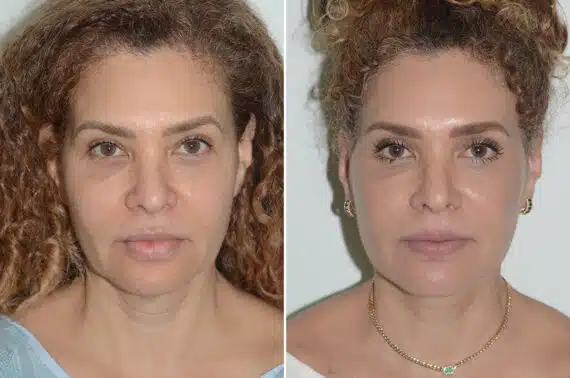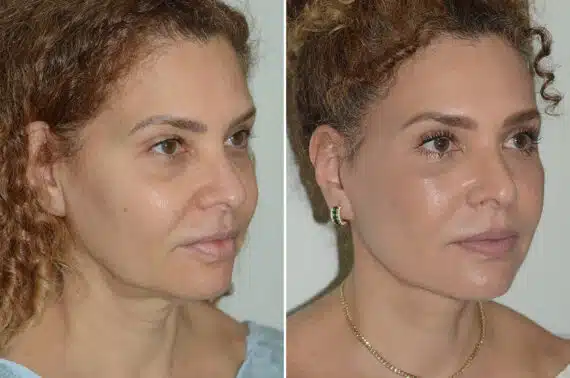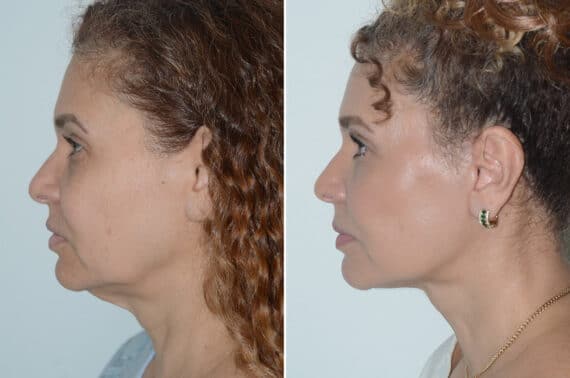A facelift can restore a more youthful look, but choosing between the SMAS and deep plane techniques depends on your goals. The SMAS facelift tightens the superficial muscle layer, offering a natural lift with moderate correction. The deep plane facelift, which works on deeper tissues, allows for more significant and longer-lasting results while maintaining a natural appearance.
With years of expertise in facial plastic surgery, Dr. Andres Bustillo provides clear and reliable guidance, helping patients understand which facelift technique best suits their needs.

5 Key Takeaways: Deep Plane vs. SMAS Facelift
- The SMAS facelift and deep plane facelift address sagging cheeks and neck but differ in how they handle deeper facial structures.
- The SMAS technique focuses on tightening the superficial musculoaponeurotic system, while the deep plane technique releases deeper ligaments for a more comprehensive lift.
- Recovery times can be similar, but the deep plane facelift often provides more durable, long-lasting results.
- Each surgical procedure carries its own set of potential risks, and patient suitability varies based on individual needs and facial anatomy.
- Dr. Bustillo’s approach to deep plane facelift surgery prioritizes natural results, making it an ideal choice for patients seeking facial rejuvenation.
How Each Facelift Surgery Addresses Aging Signs
Aging impacts not only the outer layer of skin but also deeper tissues like the SMAS layer, ligaments, and muscle structures. Traditional facelifts often focus on lifting the superficial layers and removing excess skin. However, more advanced surgical procedures aim to reposition the deeper facial muscles for improved longevity and a more natural appearance. Both the SMAS facelift and the deep plane facelift surgery work by addressing sagging skin and laxity in the cheeks, jawline, and neck. The key differences lie in how extensively each technique releases and repositions deeper tissues.
Facelift procedures can be customized to each patient, especially when performed by a skilled plastic surgeon. By tailoring surgery techniques to your facial structure, the surgeon can help you achieve a youthful contour while preserving essential elements like facial expression and individualized features.
The SMAS Facelift and Its Approach to Facial Rejuvenation
The SMAS facelift is a traditional facelifting technique that focuses on the superficial musculoaponeurotic system (SMAS layer). This layer lies just beneath the skin and above the deeper facial muscles. During an SMAS facelift, incisions are typically made around the ears and along the hairline. Through a carefully planned dissection, the surgeon lifts and tightens the SMAS layer. Excess skin is removed, and incisions are closed.
Because the SMAS plication facelift tightens the superficial layer rather than releasing deeper ligaments, some patients may not get the same level of mid-face or deep cheek rejuvenation as with other facelift options. However, the SMAS facelift can still be a viable choice for individuals who have less advanced signs of aging or prefer a more conservative approach.
The Deep Plane Facelift and Its Impact on Facial Structure
In contrast to the SMAS facelift, the deep plane facelift technique goes beneath the SMAS layer to lift and reposition facial tissues more comprehensively. By working in deeper tissue planes, the surgeon can release and adjust the ligaments that cause the cheeks and neck to droop over time. This deeper release allows for a more substantial lift, particularly in the mid-face, giving patients a naturally youthful appearance that often lasts longer than results from traditional facelifts.
Deep plane facelift surgery involves carefully separating the deeper tissue layers so that the cheeks and other facial structures can be repositioned in a more harmonious way. Because the deeper plane is addressed, patients may experience less tension on the skin. This approach can reduce the risk of an overly pulled or “done” look, resulting in a more natural contour. Dr. Bustillo specializes in this advanced deep plane technique, ensuring patients benefit from a thorough understanding of facial anatomy and an expert surgical approach.
Differences in Surgical Techniques
SMAS Facelift: Layer Elevation and Adjustment
During a traditional SMAS facelift, the surgeon elevates the SMAS layer through incisions around the ears, hairline, or potentially under the chin for a neck lift. The SMAS layer is then tightened or plicated (folded and sutured) to restore definition to the jawline and mid-face. This surgical procedure can smooth wrinkles, reduce jowls, and improve the appearance of the neck. However, because the deeper facial ligaments are not fully released, the results may be slightly less comprehensive and may not last as long as a deep plane lift.
Deep Plane Facelift: Deeper Tissue Release
The deep plane facelift provides a more extensive facial rejuvenation by freeing deeper ligaments and repositioning the SMAS layer along with additional underlying structures. This approach allows the facial tissues to be lifted as a cohesive unit, often resulting in better volume restoration in the cheeks. The incisions are similar to those used in a SMAS facelift, but the dissection goes deeper to release tethering points that contribute to sagging skin. Because the tension is removed from the skin itself and distributed through the deeper layers, patients can often enjoy more durable, natural-looking results.
Questions about your procedure?
Schedule a consultation with Dr. Andres Bustillo.
Expected Recovery and Healing Process
Recovery Timeline and Healing Stages for the SMAS Facelift
Recovery from a traditional SMAS facelift typically involves some bruising and swelling during the first two weeks. Many patients can return to non-strenuous activities within 10 to 14 days, although the final result may take a few months to fully emerge. The initial phase involves rest, the use of cold compresses, and avoiding heavy lifting or vigorous exercise. Most individuals can resume normal work activities within two to three weeks.
As with any surgery, close follow-up with your plastic surgeon ensures that any issues are quickly addressed. This might include monitoring incisions for signs of infection, checking the healing progress, and scheduling follow-up appointments to evaluate your recovery.
Recovery Timeline and Healing Stages for the Deep Plane Facelift
Deep plane facelift patients experience a recovery process that is often comparable to that of a traditional SMAS facelift, though some individuals may notice less skin tension. Bruising and swelling are common in the first one to two weeks, after which most people can gradually resume everyday tasks. Strenuous exercise and heavy lifting should be postponed for at least a few weeks, or until cleared by your facial plastic surgeon.
Because the deep plane technique addresses deeper tissues and ligaments, the final refined results may take a few months to become fully visible. Regular follow-up appointments with your surgeon are essential to ensure proper healing. Dr. Bustillo places great emphasis on personalized care during the recovery period, providing specific guidelines to minimize discomfort and speed up healing.
Long-Term Outcomes and Longevity of Results
How Long Do SMAS Facelift Results Typically Last?
A traditional SMAS facelift can provide rejuvenation that lasts several years, typically around five to seven years or longer, depending on factors like skin quality, genetics, and lifestyle. While the SMAS facelift successfully addresses many visible signs of aging, some patients may experience a gradual return of sagging in the mid-face or neck because deeper ligaments are not fully released.
How Long Do Deep Plane Facelift Results Typically Last?
Deep plane facelift results can last significantly longer, often up to 10 years or more. By addressing the deeper structures, the deep plane technique yields a more comprehensive lift. This means the cheeks, jawline, and neck can remain firmer for a more extended period. Patients often report that their results look natural and age gracefully over time, without the abrupt transition that sometimes occurs with traditional facelifts.
Potential Risks and Complications of Facelift Procedures
Potential Risks Associated with the SMAS Facelift
Like all surgical procedures, the SMAS facelift carries some risks. These can include bleeding, infection, nerve injury, and unfavorable scarring. However, serious complications are rare when a qualified plastic surgeon performs the procedure. To minimize risks, it’s important to follow pre- and post-operative care instructions closely and attend all scheduled follow-up appointments.
Potential Risks Associated with the Deep Plane Facelift
Deep plane facelift surgery also has possible complications, including bruising, swelling, infection, nerve damage, and hematoma formation. Because the dissection is more extensive, it requires the skill and expertise of a highly trained facial plastic surgeon. Dr. Bustillo has extensive experience performing deep plane lifts and employs advanced techniques to significantly reduce these risks. He will discuss all potential complications in detail during your consultation, ensuring you feel informed and comfortable about your decision.
Choosing the Right Option Based on Your Needs
Who Benefits Most from a SMAS Facelift?
A traditional SMAS facelift may be best for individuals who have moderate signs of aging, primarily in the lower face and neck. Patients who want to address early jowling or mild sagging skin could benefit from the SMAS technique. Additionally, those looking for a less extensive surgery or who prefer shorter operative times may consider the SMAS approach. However, it’s crucial to have realistic expectations about the scope and duration of the results.
Who Benefits Most from a Deep Plane Facelift?
Patients with more significant aging concerns in the mid-face, cheeks, and neck often gain the most from a deep plane facelift. If you desire comprehensive, longer-lasting results, the deep plane approach may be the right facelift procedure for you. By lifting and repositioning deeper tissues, this method can address multiple areas of facial sagging in one surgery. Dr. Bustillo, a leading facial plastic surgeon specializing in the deep plane technique, works closely with each patient to ensure that their personalized goals and anatomical considerations are met.
Final Thoughts on Selecting the Best Facelift and the Best Surgeon for You
Whether you are leaning toward a SMAS facelift or a deep plane facelift, seeking a reputable surgeon is essential. Dr. Bustillo is a dedicated facial plastic surgeon in Miami who specializes in deep plane facelift procedures, offering an in-depth consultation to evaluate your needs and discuss the benefits of each approach. While both SMAS and deep plane facelifts can deliver impressive rejuvenation, the deep plane facelift often provides a more thorough improvement that addresses the deeper structures of the face, potentially yielding longer-lasting and more natural-looking results.
There is no one-size-fits-all solution in cosmetic surgery. Your facial anatomy, aesthetic goals, and overall health play a significant role in determining which type of facelift is most suitable. If you want to learn more about deep plane facelift surgery and whether it is the right facelift procedure for you, schedule a consultation with Dr. Bustillo today. With his experience, personalized care, and commitment to achieving natural results, you can look forward to a refreshed, confident appearance that stands the test of time.




